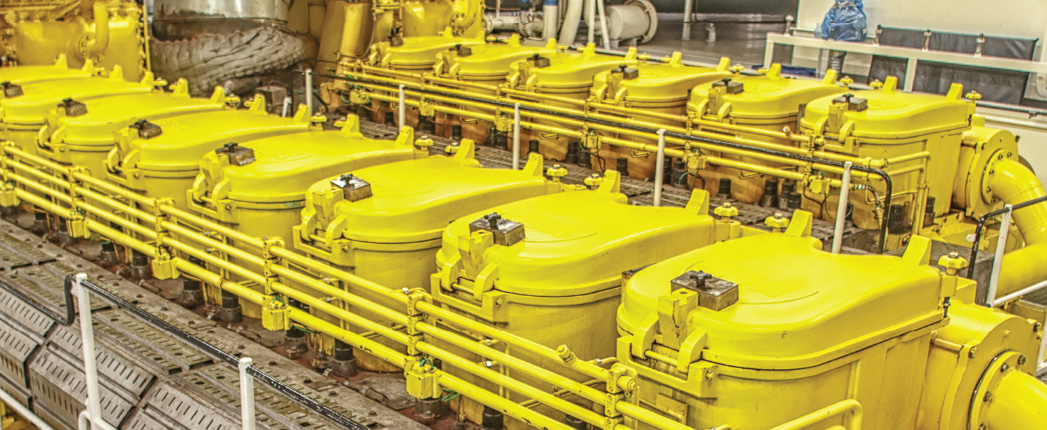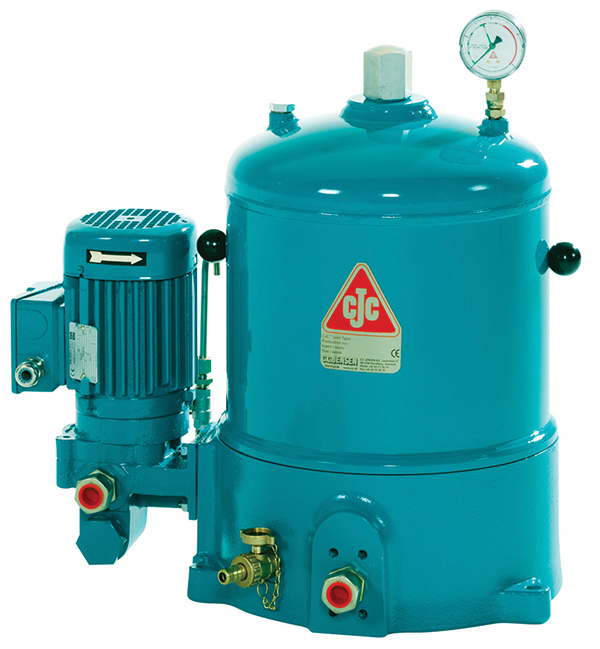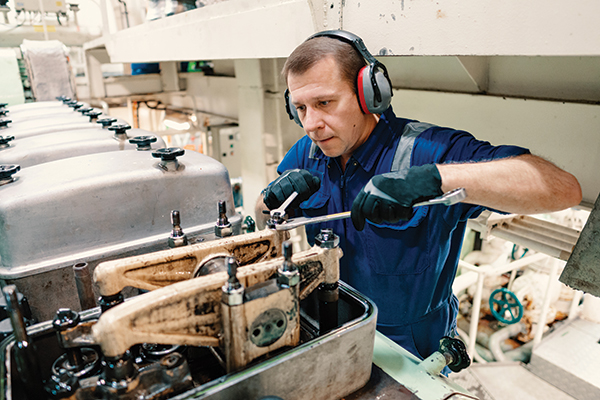
Filtration of lubricants is certainly not a new concept. However, with greater emphasis now being placed on increasing sustainability profiles while also decreasing operating costs, researchers and developers have been diligently working to come up with new and improved filtration technology. Cue the emergence of double separation technology, which has the ability to remove contaminants that are smaller than a single micron, a feat that has not been possible until recently.
Offline Filtration
Offline filtration, often called kidney loop filtration, works by drawing a lubricant from a reservoir using a pump, circulating it through a short filtration circuit, and returning the now-clean fluid to the reservoir.
There are significant challenges involved with “benchmarking technologies for offline filtration against each other,” said Kim Kjaer, global segment manager for CC Jensen A/S, in an August 30 webinar hosted by Riviera Maritime Media. “An off-line filter is basically a filter with its own pump or a different technology—like a purifier or anything else that is circulating the oil in the tank … The situation is that there are no standards for benchmarking or improving your products for offline methods.”
Because of this, Kjaer explained that CJC created its own method to benchmark different filtration technologies as well as to ensure the quality of its own filtration products. “What is important is to remove particles, of course,” he said. “It’s important to remove varnish, it’s important to remove water, and the economy is important.”
CJC used filters from three different suppliers as well as one of its own filters to demonstrate filter effectiveness over time. The method focused on four measurements: particle removal, varnish removal, water absorption and dirt capacity.
What are some of the vital abilities of offline filters?
“One thing that is important with offline filters is the lifetime of the elements,” Kjaer said. “Most of the suppliers on the market have elements that can last maybe up to a year before they have to be changed … But efficiency-wise, that means that the micron rating and the efficiency of the filter actually has to be the same—or close to the same—from when we start with a new filter and then for a year after. Therefore, it is very important to have proof that the efficiency and the micron rating is degraded as little as possible during the lifetime of the element.”

CJC’s filter began its cycle with 99.9% efficiency, but that efficiency decreased to 99.5% after three days, Kjaer said. Meanwhile, a competitor’s filter began with 74% efficiency and decreased to just 20% after three days. This steep decline in the filter’s efficiency demonstrated why “it is very important to ask for efficiency ratings over time,” he said.
What are some other vital characteristics that an offline filter should possess? Kjaer listed the following:
- Ability to keep particles trapped in the event of start-stop conditions or other changes to the system
- Optimal flow according to the volume and ingress of contaminants
- Rigorous testing that has been completed with contaminants that very closely mimic real-life contaminants
- Maximization of dirt, water and varnish holding capacity without compromising oil cleanliness
DST Promotes Circular Oil Use
There has been a shift from past paradigm in which oil was seen as a consumable, said Mats Norling, technical sales and business development manager for SKF, in the Riviera webinar. Now, with virtually every company looking for ways to increase their sustainability and cut costs, oil is often perceived as more of an asset.
“What we are looking at today is that we can actually see the oil as an asset,” Norling said. “An asset is, of course, where we need to implement a maintenance strategy.”
Historically, the two major maintenance considerations when it came to marine lubricants were viscosity and operating time. “Let’s say after 250 hours you were to replace the oil in the engine,” Norling said. “Can we change that? Yes, today we can” with the help of enhanced filtration technology.
How might this work?
“Particles in an oil are the oxidation catalysts, so it is important to understand that particles in all sizes will be the bearer and igniter of the oxidation,” Norling explained. “But if we remove the micro-sized particles, we have only removed 20% of the surface area in the particle volume in the oils; the rest is nano-sized.”
Can the remaining 80% of these particles be removed? In short, the answer is yes.
“Today, we have something called the DST technology, or double separation technology,” Norling said. “That means that we have a chemical booster that we impregnate into the filter element, so the cellulose material is impregnated with this DST booster. Then we can attract the very small particles that are part of the problems in wear but also for the oxidation process.”
How does this booster work in practice?
“The booster attracts all the particles and clumps them together, so they form a large lump,” Norling said. “These are then easy to absorb or sediment, depending on the filtration technology we’re using.”
SKF’s RecondOil Box—an offline kidney loop solution that offers varnish removal and water removal in addition to nanofiltration—works by absorption. “When it comes to the RecondOil Box, the particles will be absorbed in the filter element,” Norling said. Both micro- and nano-sized particles are captured in this process.
So what are the benefits of this enhanced form of filtration?
First and foremost, DST contributes to a reduction in the total cost of oil. “When we have this kind of technology now, when it comes to nano-sized where we will reduce the oxidation speed, first of all we can see that a total oil cost reduction will be eminent, since we don’t need to replace the oil—at least not as much as before,” Norling said. “And in some cases, we don’t need to replace the oil at all. We can monitor, we can analyze and we can ‘re-additivate’ the oil when the consumed additives are depleted in the level where we need to take some action. But the base oil is still there and good for use.”
DST can also offer some performance improvements. “If we don’t have any wear particles, then we can see the bearings of course will last longer,” Norling said. “The same thing applies to seals. That is something we know when it comes to maritime requirements—seals are often an issue when it comes to wear and leakage.”
|
“We can see that if we don’t need to replace one cubic
meter of industrial oil, that means a saving of 3,800
kilos of carbon dioxide.”
– Mats Norling, SKF |
Sustainability can be boosted by employing DST, too. After all, if the oil does not need to be changed, less oil is used overall, reducing the user’s carbon footprint.
“A life cycle analysis has been done when it comes to the double separation technology and with the RecondOil Box with DST-activated filters,” Norling said. “We can see that if we don’t need to replace one cubic meter of industrial oil, that means a saving of 3,800 kilos of carbon dioxide. That is a direct value that comes with the sustainability.”
Real World Benefits of RecondOil
SKF’s RecondOil was installed at the company’s Cassino factory in Italy in 2019. “It is basically installed on a system that is circulating 50 cubic meters of Honilo 980 oil, and it is used to hone the raceway of the bearings,” said Giovanni d’Agostino, Cassino factory manager for SKF. “In this factory we produce about a half million bearings per day.”
The RecondOil filtration capacity is about 7.2 cubic meters per day, with a 16-hour cleaning cycle. “This unit is installed just before a traditional filtering system that is the national standard with celite filtering pipes,” d’Agostino said.
What immediate benefits did the factory reap from implementing RecondOil?
“We observed a reduction of the contamination from 4.85 milligrams per liter to 3.40 milligrams per liter,” d’Agostino said. “Think about the new oil—just brand new when you buy it—it has a dirt content of 2.8 milligrams, so very close with the double separation technology system. We get cleanliness that is very close to the level of brand new oil.”

In fact, d’Agostino explained that running its honing oil through RecondOil at the Cassino factory resulted in several months in which the oil contained just “2.5 milligrams per liter of contamination, which is basically even better than new oil.”
RecondOil also provides operational perks. Overall data for the factory indicated a reduction in groove roughness of 16% on the outer ring raceway and 29% on the inner ring raceway. This reduction then led to a higher expected level of performance.
“This means that the performance of the bearing—of the product—is going to be impacted in a positive way,” d’Agostino said. “You can imagine that this would have a positive impact on all the hydraulic or mechanical devices where you can use the RecondOil filtration system.”
Furthermore, the RecondOil system has the ability to conserve even more oil by removing it from rings and returning it to circulation. “By having very clean oil, the rings after the honing operation are coming out quite clean—much cleaner than before. So that brought us to think about recovering the remaining oil—which is just a film on the rings—by sucking with air and throwing this oil back to the system,” d’Agostino explained.
After completing this process, SKF observed that “the rings were very, very clean,” d’Agostino continued. “So then we thought, well, we can remove washing operations, and we can remove the drying operation that we have after washing. By the fact of implementing RecondOil, by the fact that the oil is so much cleaner, by the fact that the raceways are so fine now, we are able now to remove up to two washing operations and one drying operation.” This further contributes to sustainability goals and enhances cost savings.
Sydney Moore is managing editor of Lubes’n’Greases magazine. Contact her at Sydney@LubesnGreases.com